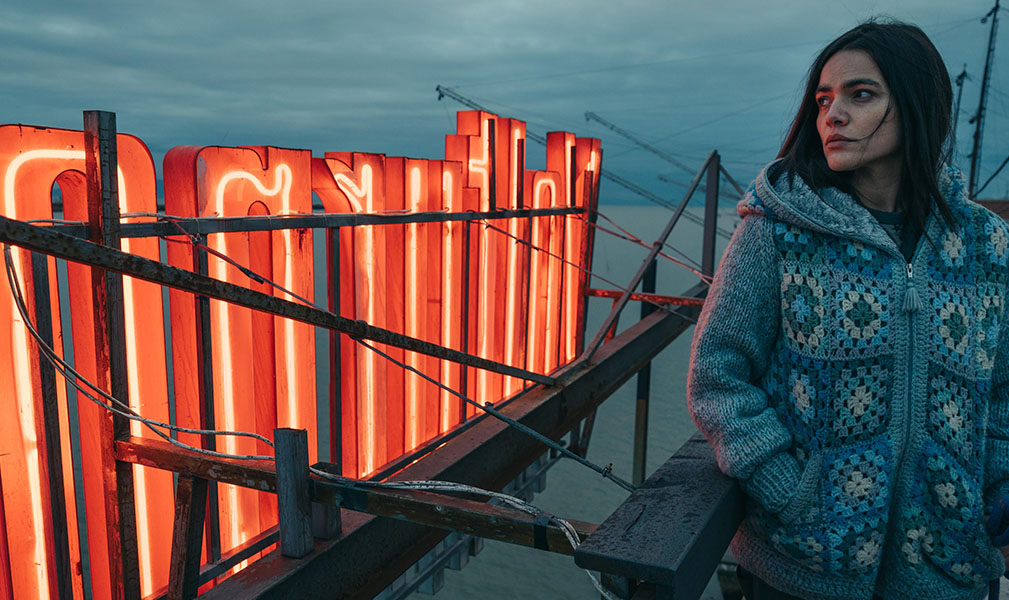“Remember, misery isn’t the only thing that exists,” Tina tells Maria (Pina Turco) just before the former gets married in “The Vice of Hope,” though she isn’t convinced. Tina’s wedding day is prompted by imminent surgery for a tumor she discovered after thinking she might be pregnant for the fifth time, a concern for many in the seaside town of Castel Volturno where prostitution and off-the-books surrogate pregnancies are made to seem like the only ways to make a living for women in a place that exceeds the reach of law enforcement. Maria can hardly afford to be miserable, protecting herself as much as she can from those other lines of work by ferrying around pregnant women to give birth to babies that will be sold off in short order, but Edoardo De Angelis’ stirring fifth feature finds the young woman at a moment where she can no longer take cover.
As horrific as the circumstances are that De Angelis illustrates for Maria, who tends to a seemingly ailing mother and toils in service of the uncharitable Aunt Mari, whose early matronly appearance, preparing gnocchi for the expectant mothers before their treacherous journey, gives way to something far more sinister, “The Vice of Hope” recognizes that Maria can’t stop moving, giving an unusual energy to a film that’s subject matter would typically drown it in despair. Filled with vibrant colors, spirited Italian pop and a camera that’s always steady but rarely still, the film pulls the curtain back on a world that lurks just underneath civil society where money feels impossible to come by so the only thing left to trade on is their human capital and the floating feeling that Maria has as she disconnects spiritually from it to inure herself emotionally, illuminated with de Angelis’ use of long, elegant tracking shots, builds up tension to the point when it’s truly devastating when she can’t remain be passive in her own experience.
Following the film’s premiere at the Toronto Film Festival, de Angelis and Turco, with the help of a translator, spoke about their fruitful partnership both on screen and off, working tirelessly to get the elusive sensation of authenticity into their work and the inspiration behind “The Vice of Hope.”
How did this come about?
Edoardo de Angelis: After I made a film on separation [“Indivisible”], I wanted to make a film on reconciliation. I thought about how everything seems dead in winter and we’d light up a fire to warm ourselves while we were awaiting the rebirth of nature. Because we work together, Pina and I dreamt about this [together] and we saw this image of a baby being born and it starts with the primordial foundations of nature – water, land, fire and air — so this brought the desire to tell the story.
Did that immediately lead you to think of Castel Volturno as a setting?
Edoardo de Angelis: Yes, Castel Volturno is a land that continues to inspire and suggest stories of people who [have spaces] very far between them, but they all inhabit this refuge of sinners — people who run away from war, from famine, and failed middle class and bourgeois people. There are different kinds of escapes from a desperate existence and different kinds of desperation, but desperation and despair bring you to the same place where the soul resides and I can touch this place. I can touch the water and I can breathe the air and I can sense the miasma and the perfumes and this place for me is Castel Volturno.
Pina, how’d you find your way into this character of Maria?
Pina Turco: During the preparation, Edoardo kept telling me, “You’re not ready, you’re not ready. You’re not working hard enough. There’s something that you’re missing.” And I decided to optimize this scolding and turned this phrase into a resource because I locked onto the fact that there’s something evanescent about this character, something that escapes us and that we don’t quite grasp and I wanted to make this the key.
Edoardo de Angelis: There’s a lot of talk about natural acting and this is an aesthetic result that you can reach very often with nonprofessional actors, but this form of acting is never enough for me. I think you can achieve the fullest type of natural acting through a strenuous, obsessive, enervating work. It’s like training for the Olympics, You have an extreme amount of physical work in order to make these physical gestures seem natural and second nature to you so that you reach a point where you no longer need the thought that is required to generate that gesture.
The camera feels so connected to Maria – what’s it like joining the performance to the perspective and creating those long takes?
Pina Turco: [smiles] Ehhhh…
Edoardo de Angelis: For everybody it’s difficult. Even for the [cinematographer] because they ask me, “Which is the field [of vision]?” and my answer is always, “Everywhere.” We know when a scene starts, but nobody knows when a scene will stop because we use the script and we rewrite, rewrite, rewrite and then we put this script inside the body and the soul of the actors, the technicians, the [cinematographer], the art director, the costume designer, and the producers too – we need to put everything inside and then forget it. Then I let all these people live this story and when you live a story, you can’t cut every time. You can’t build a [dramatic] sequence like a puzzle. You need to live that scene from beginning to end. So you never know when I will say “Cut.” For the actors, it’s difficult, but all I asked was for them to forget the camera – it’s my problem how the camera will follow them. They don’t ever need to think about where the camera is – how far [away] it is or what’s shooting exactly. They just need to live that scene.
Pina Turco: Every scene I ask Edoardo, “Please cut. No. Cut. Just once… Shot and reverse shot. Come on, it’s a classic scene [set-up], right?” [And he says] “No, no, shut up. Go there.” [laughs] The crew was all sweating and there’s always a lot of whisperings around Edoardo’s films. If you were to shoot a behind-the-scenes type of movie, you’d get a lot of material because everybody’s always talking. [laughs] They don’t want Edoardo to hear, but they have a lot of things to say, like “It would be nice to work on a simple set and simple set-ups,” but they don’t have the courage to tell him because it’s very tiring. But this is also a technique that brings out the best in everybody and gets to the truth of a scene, [which is] why everybody loves it in the end and they continue to work with him over and over.
Edoardo de Angelis: There is always a simple way to make things — a scholastic way — but it’s so boring. My form of respect and love for people that go to watch my movies is always to try and research a new language, to cross the line every time. I have my own method for understanding if I’m doing something right or wrong and it’s if I propose something to you that you already know or that you’ve seen before, then I feel a sense of shame because there’s no reason to come to me and live an adventure that you’ve already lived somewhere else. I will not feel shame if I show you a new adventure in a location that you’ve never seen before with human beings that you don’t know, who may seem very far at the beginning, but then gradually you get to know as time goes by.
When you let that life in, are there any surprises that may have made it into the film that you now like about it?
Edoardo de Angelis: They happen. All the meticulous prep work that we do, anticipating every little detail in a miniscule manner, organizing the shoot – all of this has one goal and that is to prepare for that surprising moment that occurs when all of these ideas become flesh and bone. That’s where my ideas change. They grow and evolve and I end up marveling at the result. Everything is geared towards creating an unexpected miracle that resembles life, otherwise the sense of wonder that you feel in the end resembles that of a primitive man faced with the incomprehensible phenomenon of nature that he can’t control. The marvelous thing about cinema is that it offers the evolution of man who becomes aware of everything except the unexpected and then the sense of marvel brings about a growth in you.
The soundtrack of the film is quite special and would seem to incorporate local music. How did you create the score?
Edoardo de Angelis: Yes, this is the second film that I make in collaboration with Enzo Avitabile and his music is very much rooted in the land, but it’s also open to different types of sounds. This creates a cross-contamination with other entities and there is a musical aspect of the land that is reflected in the story, so you have the notes that you hear on the soundtrack reflect the beauty and the pain of the land that is the focus of the story. There are two elements – this generation of human beings [in desperate straits arriving] and their stories and the tears and the hospitality, the welcoming that this land offers. It’s not important where a man is born, but what’s important is where a man goes to die.
What’s it like to get to the finish line and the premiere?
Pina Turco: I feel exactly like Maria – empty. [laughs] [When we finished filming] I feel exactly this [same] sensation of… [breathes out] I remember I burst out laughing.
Edoardo de Angelis: The overwhelming feeling that I have is a sense of liberation and freedom. Yesterday, it was a perfect moment to finish the film and present it because we were able to see the completed film for the first time and now we are starting to move away from it. But the film, more than any other film that I’ve made, connects me to something that deeply moved me because [Pina and I] decided to have a child and the development of the film accompanied the child’s birth — the film contains a tangle of feelings that led myself and Pina to decide to start a family. So we will never be separated from this film, but here we begin to enjoy the fruits of the film, primarily the fact that we have completed something that used to belong to us and now it belongs to everybody.
“The Vice of Hope” does not yet have U.S. distribution. It will next play at the London Film Festival on October 20th and 21st at the BFI Southbank Theaters and the Rome Film Festival from October 18th-28th.




